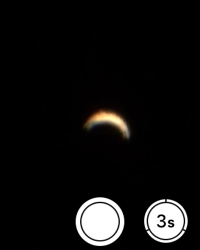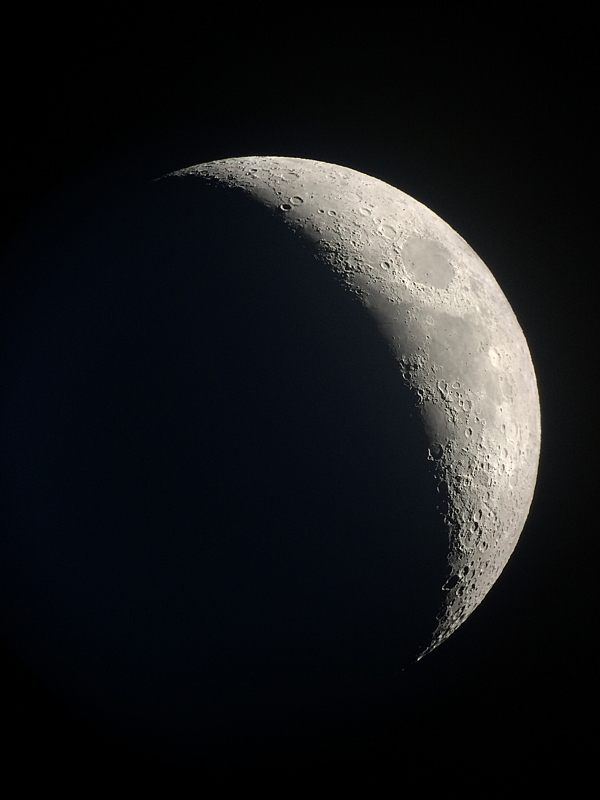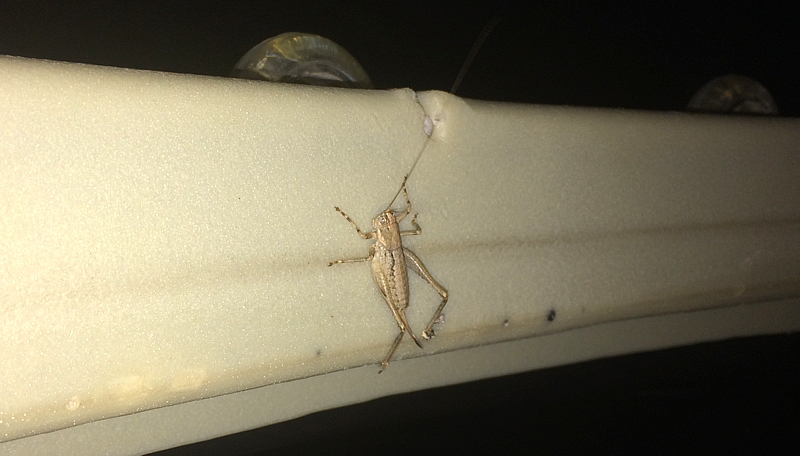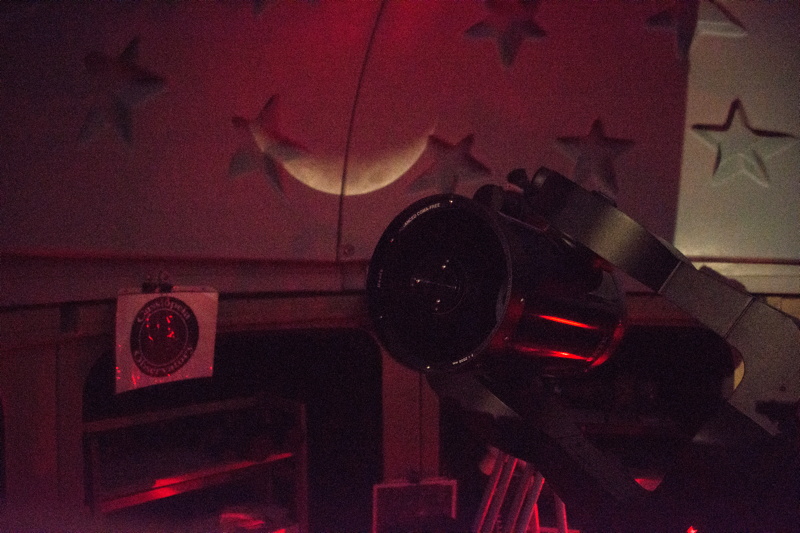3" Newtonian test; iPhone: Venus, Moon, Saturn, Pluto (?);
D7200 DSLR NGC7380 (Wizard Nebula)
Posted: 21 July 2015
Monday, 20 July 2015, dawned mostly clear, but by mid-morning clouds had started building up. However, as sunset approached the sky began clearing up.
|
Open: Monday, 20 July 2015, 1900 MST Temperature: 93°F |
Session: 848 Conditions: Mostly clear |
Synced observatory clock to WWV. Then set up my old (1961) Edmund Scientific 3" Newtonian telescope:

I hoped that my recollimation attempt was successful. Would found out shortly.
1917 MST: took quick looks at Venus, Jupiter, and the Moon at 83X in the Meade 8" LX200-ACF telescope. Then returned to the 3" Newtonian and viewed the Moon at 60X. The view was not as crisp as I remember it being in the past. One side of the Moon would be sharp but the other side of the Moon would be doubled. I viewed Venus at 60X and could see the doubling effect. This handheld iPhone afocal 60X photo shows the double image:

Since I've done all I can do for collimation I'm suspecting that the mirror coatings (primary and/or secondary) have begun to deteriorate after 50+ years.
1933 MST: sunset. Gave up on the 3" telescope and resumed using the 8" in the observatory. Mounted the iPhone 5s on the telescope using the MX-1 Afocal Adapter. This is a stack of 1763 frames from a slo-mo video (120 fps), afocal 154X + full digital zoom:

This is a live view of Venus as seen on my Apple Watch:

The Moon, iPhone 5s, afocal 77X:

2008 MST: removed the iPhone and switched to using the Baader 8-24mm Zoom Eyepiece. Viewed Venus and the Moon at various magnifications. I noticed that I had a visitor:

I then took this iPhone photo of the western sky using NightCap Pro showing the crescent Moon, Venus, and Jupiter. Some Earthshine is visible on the Moon.

Mouseover or tap on image for labels
2023 MST: viewed Saturn using the zoom eyepiece. Then mounted the iPhone using the MX-1 Adapter. This is a stack of 1166 slo-mo frames, 154X + some digital zoom:

Resumed Saturn observing using the zoom eyepiece. Seeing was not great but occasionally there were good views at 250X (8mm).
2053 MST: began viewing some Deep Sky Objects (DSO) using the zoom eyepiece. Viewed Epsilon Lyrae (Double-Double Star), Albireo (double star), M57 (Ring Nebula), M20 (Trifid Nebula), M22 (globular cluster), M4 (globular cluster), M8 (Lagoon Nebula), and M17 (Swan Nebula). The best views of nebulae were using 83X (24mm); best views of globular clusters at 83X (24mm), 100X (20mm), and 125X (16mm).
Returned to M22 and SYNCed the AutoStar on its location in preparation for my iPhone Pluto imaging attempt. Then switched back to the 2" 24mm UWA eyepiece. Viewed M5 (globular cluster), M16 (Eagle Nebula), and IC4756 (open cluster).
Slewed the 8" telescope to the Moon and at 2129 MST I took this D7200 DSLR, f/3.5, 20 seconds, ISO 2500, FL 18mm, photo of the crescent Moon projected onto the observatory dome:

I then began preparing for my attempt to image Pluto using NightCap Pro on the iPhone. I had made a previous attempt back on 10 July 2015 but had been clouded out on subsequent nights so was unable to confirm whether or not Pluto was imaged. I slewed the 8" telescope to Pluto using the AutoStar. As I looked into the eyepiece a faint equatorial orbit satellite passed slowly through the field-of-view (FOV), 83X. Switched to the MX-1 Afocal Adapter, 77X. Began waiting for the Moon to get lower in the sky. While waiting I also prepared the D7200 DSLR for DSO imaging.
2205 MST: The Moon was now low enough to make the Pluto imaging attempt. Powered on the GC Wi-Fi Adapter and used SkySafari Pro on the iPhone 5s to GOTO Pluto. This is the SkySafari chart for the view of Pluto:

2214 MST: Pluto may be in this image, NightCap Pro (Long Exposure, Light Boost, ISO 8000, 1/2sec, 1 minute exposure):

Hopefully I will get a confirming image about 24 hours later.
2225 MST: unmounted the MX-1 and added the f/6.3 focal reducer to the 8". Viewed NGC7380 (Wizard Nebula), 24mm + focal reducer. A portion was faintly visible. Then slewed to the star Shedir for a focus test image. Mounted the D7200 DSLR at prime focus + focal reducer + extension + off-axis guider. Did a focus test using the Bahtinov Mask. Slewed to NGC7380 and found a faint guide star. Did a framing test exposure. I then did guided 5 minute exposures at ISO 6400 and ISO 12800. This is a slightly cropped ISO 12800 image:

2257 MST: ended imaging. Viewed M31 (Andromeda Galaxy) and its companion galaxies M32 and M110, 24mm UWA + focal reducer. All three galaxies were nicely in the FOV. M31 spiral arms were visible quite a distance from the galaxy nucleus.
Returned to NGC7380 (Wizard Nebula) and viewed it with and without a 2" OIII filter. Some parts of the nebula were more visible with the filter than without it, but overall, the difference was not striking.
2323 MST: viewed Saturn one last time, 83X.
|
Close: Monday, 20 July 2015, 2334 MST Temperature: 73°F |
Session Length: 04h 34m Conditions: Clear |
Comments are welcome using Email. If you are on Twitter you can use the button below to tweet this report to your followers. Thanks.
Cassiopeia Observatory Home Page
Copyright ©2015 Michael L. Weasner / mweasner@me.com
URL = http://www.weasner.com/co/Reports/2015/07/21/index.html
